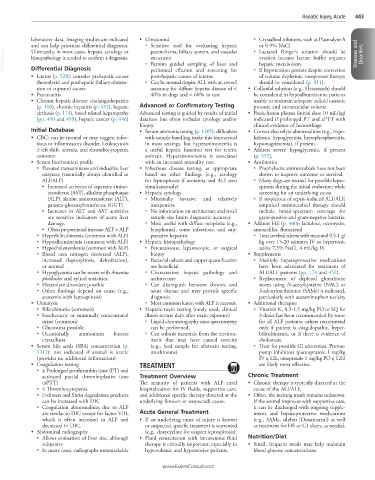Page 909 - Cote clinical veterinary advisor dogs and cats 4th
P. 909
Hepatic Injury, Acute 443
laboratory data. Imaging studies are indicated • Ultrasound ○ Crystalloid solutions, such as Plasmalyte-A
or 0.9% NaCl
and can help prioritize differential diagnoses. ○ Sensitive tool for evaluating hepatic ○ Lactated Ringer’s solution should be
VetBooks.ir histopathology is needed to confirm a diagnosis. ○ Permits guided sampling of liver and avoided because lactate buffer requires Diseases and Disorders
parenchyma, biliary system, and vascular
Ultimately, in most cases, hepatic cytology or
structures
hepatic metabolism.
Differential Diagnosis
of volume depletion, vasopressor therapy
• Icterus (p. 528): consider prehepatic causes peritoneal effusion and screening for ○ If hypotension persists despite correction
post-hepatic causes of icterus
(hemolysis) and posthepatic (biliary obstruc- ○ Can be normal despite ALI, with an overall should be considered (p. 911).
tion or rupture) causes accuracy for diffuse hepatic disease of < • Colloidal solution (e.g., Hetastarch) should
• Pancreatitis 40% in dogs and < 60% in cats be considered in hypoalbuminemic patients
• Chronic hepatic disease: cholangiohepatitis unable to maintain adequate colloid osmotic
(p. 160), chronic hepatitis (p. 452), hepatic Advanced or Confirmatory Testing pressure and intravascular volume.
cirrhosis (p. 174), breed related hepatopathy Advanced testing is guided by results of initial • Fresh-frozen plasma (initial dose 10 mL/kg)
(pp. 450 and 459), hepatic cancer (p. 446) database but often includes cytology and/or indicated if prolonged PT and aPTT with
biopsy. clinical evidence of hemorrhage
Initial Database • Serum ammonia testing (p. 1305): difficulties • Correct electrolyte abnormalities (e.g., hypo-
• CBC: can be normal or may suggest infec- with sample handling make this impractical kalemia, hypoglycemia, hypophosphatemia,
tious or inflammatory disorder. Leukocytosis in most settings, but hyperammonemia is hypomagnesemia), if present.
± left shift, anemia, and thrombocytopenia a useful hepatic function test for icteric • Address severe hypoglycemia, if present
common animals. Hyperammonemia is associated (p. 552).
• Serum biochemical profile with an increased mortality rate. • Antibiotics
○ Elevated transaminases and inducible liver • Infectious disease testing, as appropriate ○ Prophylactic antimicrobials have not been
enzymes (essentially always identified in based on other findings (e.g., serology shown to improve outcome or survival.
ALI/ALF) for leptospirosis if azotemia and ALI seen ○ Many dogs are treated for possible lepto-
Increased activities of aspartate amino- simultaneously) spirosis during the initial evaluation while
■
transferase (AST), alkaline phosphatase • Hepatic cytology screening for an underlying cause.
(ALP), alanine aminotransferase (ALT), ○ Minimally invasive and relatively ○ If suspicious of sepsis-induced ALI/ALF,
gamma-glutamyltransferase (GGT) inexpensive empirical antimicrobial therapy should
Increases in ALT and AST activities ○ No information on architecture and small include broad-spectrum coverage for
■
are sensitive indicators of acute liver sample size limits diagnostic accuracy gram-positive and gram-negative bacteria.
damage. ○ Most useful with diffuse neoplasia (e.g., • Address HE (p. 440): lactulose, neomycin,
Often proportional increase ALT > ALP lymphoma), some infections, and sup- amoxicillin, flumazenil
■
○ Hyperbilirubinemia (common with ALF) purative hepatitis ○ Treat cerebral edema with mannitol 0.5-1 g/
○ Hypoalbuminemia (common with ALF) • Hepatic histopathology kg over 15-20 minutes IV or hypertonic
○ Hypocholesterolemia (common with ALF) ○ Percutaneous, laparoscopic, or surgical saline 7.5% NaCl, 4 mL/kg IV.
○ Blood urea nitrogen decreased (ALF), biopsy • Supplements
increased (leptospirosis, dehydration), ○ Bacterial culture and copper quantification ○ Multiple hepatoprotective medications
or normal are beneficial. have been advocated for treatment of
○ Hypoglycemia can be severe with Amanita ○ Characterizes hepatic pathology and ALI/ALF patients (pp. 174 and 452).
phalloides and xylitol toxicities. architecture ○ Replacement of depleted glutathione
○ Electrolyte disorders possible ○ Can distinguish between chronic and stores using N-acetylcysteine (NAC) or
○ Other findings depend on cause (e.g., acute disease and may provide specific S-adenylmethionine (SAMe) is indicated,
azotemia with leptospirosis) diagnosis particularly with acetaminophen toxicity
• Urinalysis ○ Most common lesion with ALF is necrosis. • Additional therapies
○ Bilirubinuria (common) • Hepatic toxin testing (rarely used; clinical ○ Vitamin K 1 0.5-1.5 mg/kg PO or SQ for
○ Isosthenuric or minimally concentrated illness occurs days after toxin exposure) 3 doses has been recommended by some
urine (common) ○ Liquid chromatography mass spectrometry for all ALF patients; others recommend
○ Glucosuria possible can be performed. only if patient is coagulopathic, hyper-
○ Occasionally ammonium biurate ○ Can submit materials from the environ- bilirubinemic, or if there is evidence of
crystalluria ment that may have caused toxicity cholestasis.
• Serum bile acids (SBA) concentration (p. (e.g., feed sample for aflatoxin testing, ○ Treat for possible GI ulceration. Proton-
1312): not indicated if animal is icteric mushrooms) pump inhibitors (pantoprazole 1 mg/kg
(provides no additional information) IV q 12h, omeprazole 1 mg/kg PO q 12h)
• Coagulation testing TREATMENT are likely most effective.
○ ± Prolonged prothrombin time (PT) and
activated partial thromboplastin time Treatment Overview Chronic Treatment
(aPTT) The majority of patients with ALF need • Chronic therapy is typically directed at the
○ ± Thrombocytopenia hospitalization for IV fluids, supportive care, cause of the ALI/ALF.
○ D-dimers and fibrin degradation products and additional specific therapy directed at the • Often, the inciting insult remains unknown.
can be increased with DIC underlying (known or suspected) cause. If the animal improves with supportive care,
○ Coagulation abnormalities due to ALF it can be discharged with ongoing supple-
are similar to DIC except for factor VIII, Acute General Treatment ments and hepatoprotective medications
which is often increased in ALF and • If an underlying cause of injury is known (e.g., SAMe, silybin [Denamarin]) as well
decreased in DIC. or suspected, specific treatment is warranted as treatment for HE or GI ulcers, as needed.
• Abdominal radiography (e.g., doxycycline for suspect leptospirosis).
○ Allows evaluation of liver size, although • Fluid resuscitation with intravenous fluid Nutrition/Diet
subjective therapy is critically important, especially in • Small, frequent meals may help maintain
○ In many cases, radiographs unremarkable hypovolemic and hypotensive patients. blood glucose concentrations.
www.ExpertConsult.com

